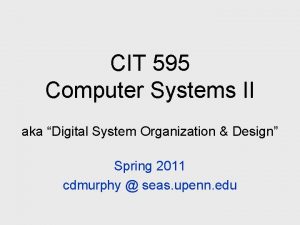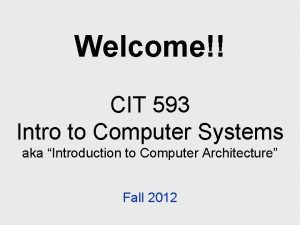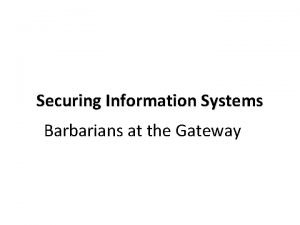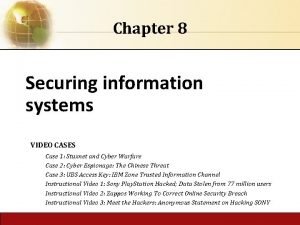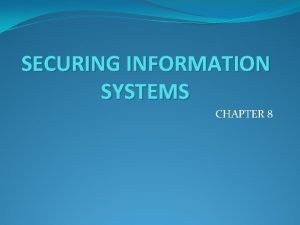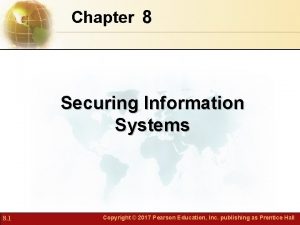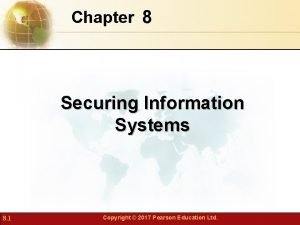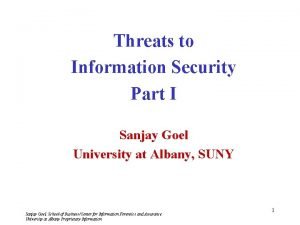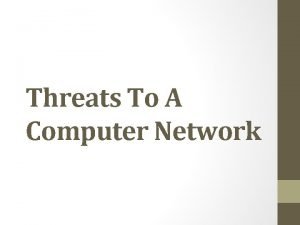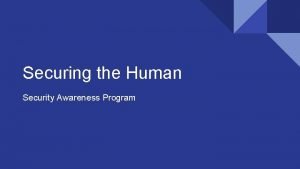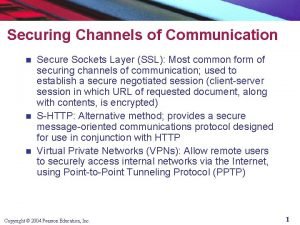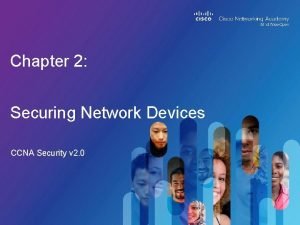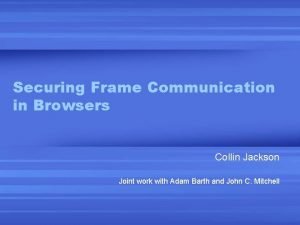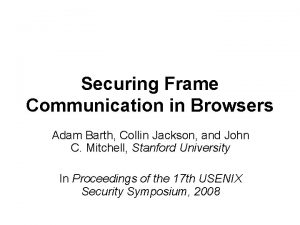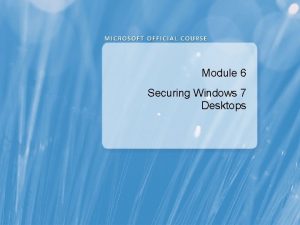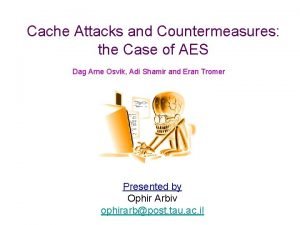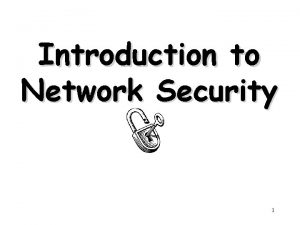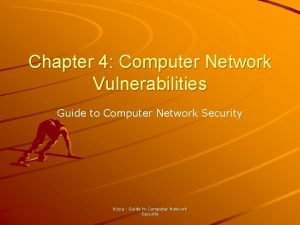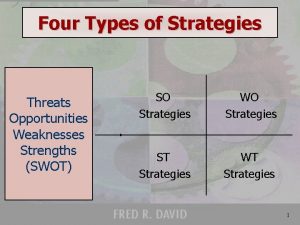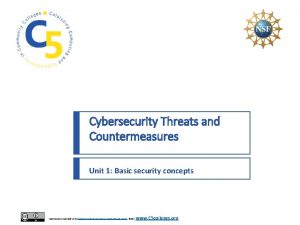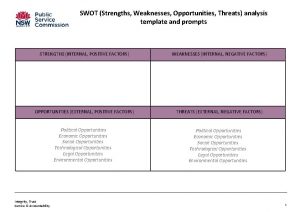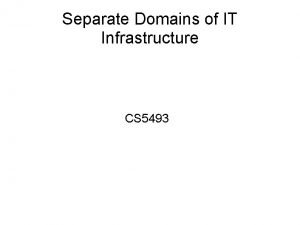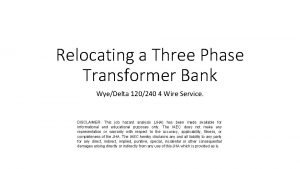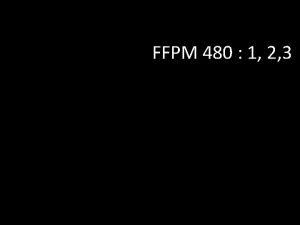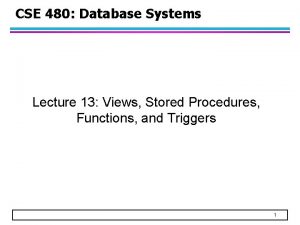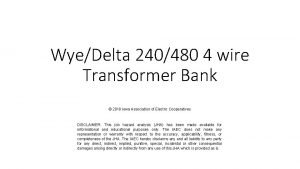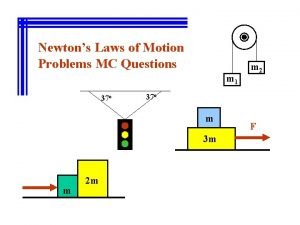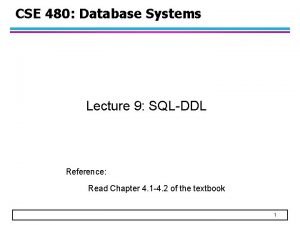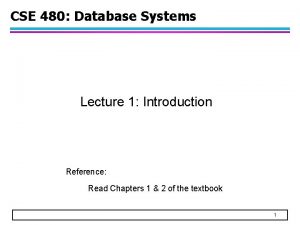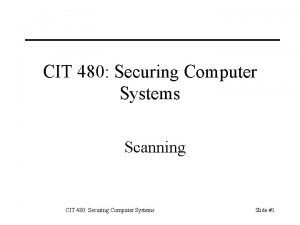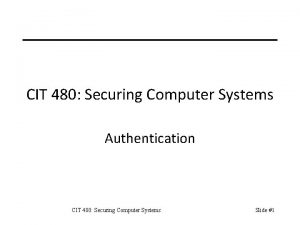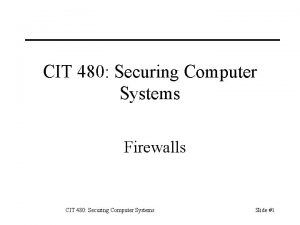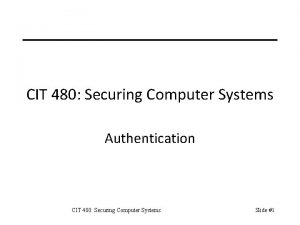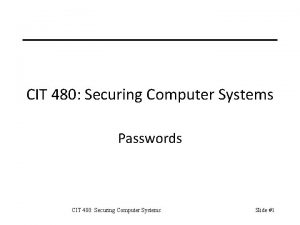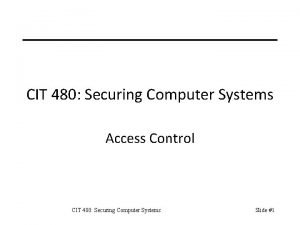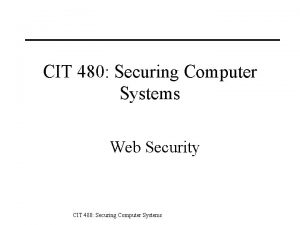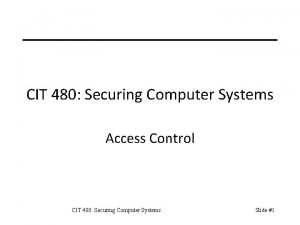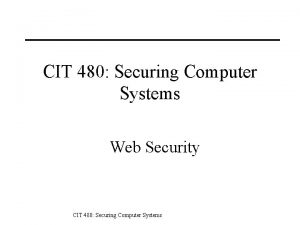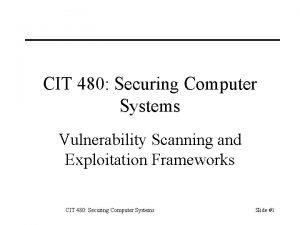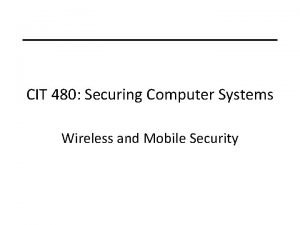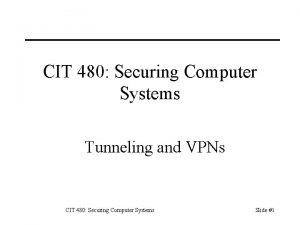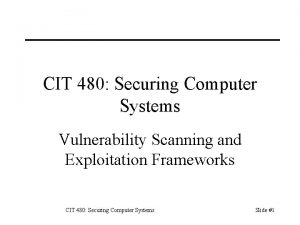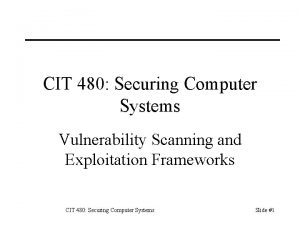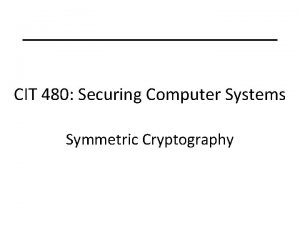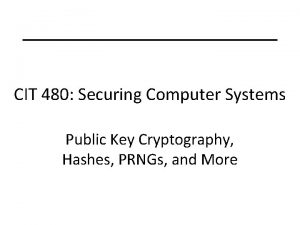CIT 480 Securing Computer Systems Threats Attacks and



























































- Slides: 59

CIT 480: Securing Computer Systems Threats, Attacks, and Vulnerabilities CIT 480: Securing Computer Systems Slide #1

Topics 1. 2. 3. 4. 5. 6. Threats Cybercrimes Attacks, Attack Surface, and Exploits Malware Vulnerabilities Mitigations and Patches CIT 480: Securing Computer Systems Slide #2

Definitions Threats are people who are able to take advantage of security vulnerabilities to attack systems. – Vandals, hacktivists, criminals, spies, disgruntled employees, etc. Vulnerabilities are weaknesses in a system that allow a threat to obtain access to information assets in violation of a system’s security policy. (2719662) Vulnerabilities in Gadgets Could Allow Remote Code Execution Attacks are actions taken by threats to obtain assets from systems in violation of the security policy. Slide #3 CIT 480: Securing Computer Systems

Who are the Threats? Hacktivists Vandals Criminals Spies Slide #4

Hacktivists attack systems for political goals. – Deface websites to spread their message (defacement of avg. com shown) – Take down sites in retribution for actions. CIT 480: Securing Computer Systems Slide #5

Vandals CIT 480: Securing Computer Systems Slide #6

Cybercriminals Focus on monetizing information via: – Identity theft (phishing) – Credit card or bank account fraud (phishing) – Extortion (via ransomware or DDo. S) – Clickjacking – Fraud (auction fraud, 419 scams, etc. ) Specialists who sell services to other criminals – Distribute malware – Rent botnet computing services CIT 480: Securing Computer Systems Slide #7

Cyberspies Threats that work for a nation state or corp: – Obtain classified information – Install backdoors for later access – Distract enemies from other operations – Destroy physical devices (Stuxnet) Terms: Cyberespionage and cyberwarfare CIT 480: Securing Computer Systems Slide #8

Insider Problem Insiders are threats who are members of the organization that they are attacking. Insiders are dangerous because they – Are inside the security perimeter, so cannot be blocks by perimeter defenses like firewalls and locked doors. – Have some level of legitimate access to systems. – May have physical access to systems and information. CIT 480: Securing Computer Systems Slide #9

Cybercrimes A cybercrime is a crime that uses a computer to commit a crime or that targets a computer in the commission of the crime. Examples of cybercrime include: – Spam – Phishing – Fraud – Harassment (cyberstalking, cyberbullying) CIT 480: Securing Computer Systems Slide #10

Spam is the use of electronic messaging systems to send unsolicited bulk messages, especially advertising, indiscriminately. – Types: E-mail, IM, wiki, comment spam. Used to deliver other attacks – Malware – Phishing and other fraud enticements CIT 480: Securing Computer Systems Slide #11

Over 90% of e-mail is spam! CIT 480: Securing Computer Systems Slide #12

Phishing E-mail CIT 480: Securing Computer Systems Slide #13

Phishing Site CIT 480: Securing Computer Systems Slide #14

Cybercrime Organization Sponsors – Governments, corporations, activist groups, organized crime, individuals. Cybercrime Boss – Works for sponsor or may be sponsor himself. – Plans crime, recruits tech providers and money mules. Technology Providers – Deployment providers – Malware authors – Botnet masters Money Mules CIT 480: Securing Computer Systems Slide #15

Threat Model A threat model describes which threats exist to a system, their capabilities, resources, motivations, and risk tolerance. Also known as an adversary model. – Four quadrant model: skill and targeting. – Resources and capabilities. – Do you keep enough data about historical incidents to know capabilities and motivations? CIT 480: Securing Computer Systems Slide #16

Four Quadrant Threat Modeling IBM X-Force 2012 Trend and Risk Report CIT 480: Securing Computer Systems Slide #17

Resources • • • Skilled personnel Money Computational power Technology Infrastructure CIT 480: Securing Computer Systems Slide #18

Capabilities Computational – Can try X keys/second or X passwords/second. Informational – Has access to {past, current, future} encrypted data. – Has access to X GB of data. Access – – Class IV Physical access. User access: none, authenticated, admin. Can read network data. Can inject packets into network. CIT 480: Securing Computer Systems Class III Class I Slide #19

Advanced Persistent Threat Advanced persistent threat (APT) refers to a group that has the ability to maintain a constant presence inside a target’s network. – – Sophisticated Targeted. Skilled personnel. May be backed with considerable budget. CIT 480: Securing Computer Systems Slide #20

Threat Information Sources • • • Computer Emergency Response Team (CERT) Krebs On Security SANS Internet Storm Center (ISC) Symantec Internet Threat Reports Threat. Post • See resources page on class site for more. CIT 480: Securing Computer Systems Slide #21

Attacks An attack is an action taken by a threat to gain unauthorized access to information or resources or to make unauthorized modifications to information or computing systems. – – – – Spoofing (pretending to be another entity) Packet sniffing (intercepting network traffic) Man in the middle (active interception of traffic) Injection Attacks (buffer overflows, sql injection, etc. ) Denial of Service (resource depletion) Defacement (vandalism) Social Engineering, etc. Slide #22

How are Digital Attacks Different? Automation – Salami Attack from Office Space. Action at a Distance – Volodya Levin, from St. Petersburg, Russia, stole over $10 million from US Citibank. Arrested in London. Technique Propagation – Criminals share attacks rapidly and globally. CIT 480: Securing Computer Systems Slide #23

Spoofing A spoofing attack is when a threat masquerades as another entity on a telecommunications network. Examples of spoofing include: – E-mail spoofing – ARP spoofing (MAC to IP address map spoofing) – IP address spoofing – Caller ID spoofing – GPS spoofing CIT 480: Securing Computer Systems Slide #24

Sniffing Packet sniffing is when a program records wired or wireless network packets destined for other hosts. – Wireless traffic is available to everyone nearby. – Antennas can extend range to miles. – Wired traffic is accessible depending on network location. – If network location unsatisfactory, ARP spoofing can redirect traffic to sniffing machine. Sniffing used to – Obtain passwords (ftp, imap, etc. ) – Obtain other confidential information CIT 480: Securing Computer Systems Slide #25

Man in the Middle A man-in-the-middle attack is an active eavesdropping attack, in which the attacker connects to both parties and relays messages between them. CIT 480: Securing Computer Systems Slide #26

Injection Attacks Injection attacks send code to a program instead of the data it was expected, then exploit a vulnerability in the software to execute the code. – Buffer overflows inject machine code into a process. – Cross-site scripting injects Java. Script code into a web page seen by another user. – SQL injection injects SQL code into a database query run by an application. CIT 480: Securing Computer Systems Slide #27

Denial of Service A denial of service (Do. S) attack attempts to make computer or network resources unavailable to its intended users. CIT 480: Securing Computer Systems

Social Engineering Social engineering is the psychological manipulation of people to reveal confidential information or perform actions to violate security policy. Slide #29

Attack Surface Attack surface: the set of ways an application can be attacked. Used to measure attackability of app. – The larger the attack surface of a system, the more likely an attacker is to exploit its vulnerabilities and the more damage is likely to result from attack. – Compare to measuring vulnerability by counting number of reported security bugs. – Both are useful measures of security, but have very different meanings. CIT 480: Securing Computer Systems Slide #30

Exploits An exploit is a technique or tool that takes advantage of a vulnerability to violate an implicit or explicit security policy. Exploits can be categorized by 1. The type of vulnerability they exploit. 2. Local (runs on vulnerable host) or remote. 3. Result of exploit (elevation of privilege, Do. S, spoofing, remote access, etc. ) CIT 480: Securing Computer Systems Slide #31

Exploitation Frameworks CIT 480: Securing Computer Systems Slide #32

Malware, short for malicious software, is software designed to gain access to confidential information, disrupt computer operations, and/or gain access to private computer systems. Malware can be classified by how it infects systems: – Trojan Horses – Viruses – Worms Or by what assets it targets: – – – Ransomware Spyware and adware Backdoors Rootkits Botnets Slide #33

How much malware is out there? CIT 480: Securing Computer Systems Slide #34

Trojan Horses CIT 480: Securing Computer Systems Slide #35

Trojan Horse Examples CIT 480: Securing Computer Systems Slide #36

Viruses A computer virus is a type of malware that, when executed, replicates by inserting copies of itself (possibly modified) into other files. This process is called infecting. CIT 480: Securing Computer Systems Slide #37

Worms A worm is a type of malware that spreads itself to other computers. CIT 480: Securing Computer Systems Slide #38

Ransomware CIT 480: Securing Computer Systems Slide #39

Information Stealers Information stealers target specific types of information, such as passwords, financial credentials, private information, etc. – Keyloggers (can be hardware too) – Desktop recorders – Memory scrapers Slide #40

Spyware and Adware CIT 480: Securing Computer Systems Slide #41

Backdoors CIT 480: Securing Computer Systems Slide #42

Backdoor Example: Dark Comet CIT 480: Securing Computer Systems Slide #43

Rootkits • • • Execution Redirection File Hiding Process Hiding Network Hiding Backdoor User Program Rootkit Operating System CIT 480: Securing Computer Systems Slide #44

Covert Channels Covert channels enable communication using techniques not meant for information exchange. – Malware could increase CPU usage to 100% to communicate a 1, regular usage is a 0. – Malware could fill a storage device to 100% to communicate a 1, non-full device is a 0. – Malware could send 2 packets/second to indicate a 1, 1 packet/second to indicate a 0. CIT 480: Securing Computer Systems Slide #45

Botnets CIT 480: Securing Computer Systems Slide #46

Vulnerabilities can be found in any software: – PC: Office, Adobe Reader, web browsers – Server: Databases, DNS, mail server software, web servers, web applications, etc. – Mobile: Mobile phone OS, mobile applications – Embedded: printers, routers, switches, Vo. IP phones, cars, medical devices, TVs, etc. – Third party software: Web browser plugins, Ad affiliate network Java. Script include files, Mobile ad libraries Slide #47

Document Format Vulnerabilities IBM X-Force 2012 Trend and Risk Report CIT 480: Securing Computer Systems Slide #48

Web Browser Vulnerabilities IBM X-Force 2012 Trend and Risk Report Slide #49

Embedded Vulnerabilities Slide #50

Mitigations A mitigation is a process, technique, tool, or software modification that can prevent or limit exploits against vulnerabilities. – A password length policy is a process mitigation to protect against password guessing attacks. – A firewall is a tool mitigation that limits exploits by blocking certain types of network traffic. – Checking for the lock icon in the location bar of your browser is a technique mitigation for verifying that web connections are encrypted. CIT 480: Securing Computer Systems Slide #51

Security Patches A security patch is a software modification designed to prevent or limit a vulnerability. A patch is a type of mitigation. – Administrator may have to apply manually. – Some vendors specify certain days to patch, such as “Patch Tuesday, ” the 2 nd Tuesday of the month when MS releases updates. – Increasingly software auto updates itself with current patches. CIT 480: Securing Computer Systems Slide #52

Vulnerability Timeline CIT 480: Securing Computer Systems Slide #53

Zero Day A zero day vulnerability, attack, or exploit is a newly discovered one for which no patch currently exists. – Once a patch is released, the vulnerability, attack, or exploit is no longer a zero day. Google’s Project Zero focuses on finding zero day vulnerabilities in open source and commercial software before attackers do. CIT 480: Securing Computer Systems Slide #54

Vulnerability Markets CIT 480: Securing Computer Systems Slide #55

Vulnerability Databases Slide #56

Time to Attack after Deployment Jan 1 2005 – Jan 1 2014 https: //isc. sans. edu/survivaltime. html

Key Points 1. Definitions 1. threat, threat model, APT, attack surface, exploit, vulnerability, mitigation, patch, zero day, malware 2. Four Quadrant Threat Model 1. 2. Expertise: off-the-shelf tool users up to sophisticated built your own Focus: broad attack anyone to targeted attacks on high value victims 3. Attack types: spam, phish, spoof, sniff, MITM, Do. S 4. Malware types: Trojan, virus, worm 5. Vulnerability lifecycle – Introduction, zero-day, patch, window of exposure 6. You can improve the security of a system by 1. Mitigating vulnerabilities 2. Reducing attack surface Slide #58

References 1. Arbaugh, William A. , William L. Fithen, and John Mc. Hugh. "Windows of vulnerability: A case study analysis. " Computer 33. 12 (2000): 52 -59. 2. Nate Anderson, Meet the men who spy on women through their webcams: The Remote Administration Tool is the revolver of the Internet's Wild West. Ars Technica, http: //arstechnica. com/tech-policy/2013/03/rat-breeders-meet-the-men-who-spy-onwomen-through-their-webcams/, 2013. 3. Honeynet Project, Know Your Enemy, 2 nd edition, Addison-Wesley, 2004. 4. IBM, X-Force 2012 Risk and Trends Report, 2013. 5. Stuart Mc. Clure, Joel Scambray, and George Kurtz, Hacking Exposed, 7 th edition, Mc. Graw. Hill, 2012. 6. Norton, Fake Antivirus, http: //www. nortonantiviruscenter. com/security-resourcecenter/fake-antivirus. html 7. Ed Skoudis, Counter Hack Reloaded, Prentice Hall, 2006. 8. Stuart Staniford, Vern Paxson, and Nicholas Weaver, "How to 0 wn the Internet in Your Spare Time, " Proceedings of the 11 th USENIX Security Symposium, 2002. CIT 480: Securing Computer Systems Slide #59
 480+480
480+480 Malicious attacks threats and vulnerabilities
Malicious attacks threats and vulnerabilities Cit595
Cit595 Cit 593 introduction to computer systems
Cit 593 introduction to computer systems Securing information system
Securing information system Securing information systems
Securing information systems Securing information systems
Securing information systems Chapter 8 securing information systems
Chapter 8 securing information systems Securing information systems
Securing information systems Chapter 8 securing information systems
Chapter 8 securing information systems Chapter 8 securing information systems
Chapter 8 securing information systems Unintentional threats to information systems
Unintentional threats to information systems Computer network threats
Computer network threats Cit 592 mathematical foundations of computer science
Cit 592 mathematical foundations of computer science The scratch stage is 480 pixels wide and 360 pixels high
The scratch stage is 480 pixels wide and 360 pixels high The scratch stage is 480 pixels wide and 360 pixels high
The scratch stage is 480 pixels wide and 360 pixels high The scratch stage is 480 pixels wide and 360 pixels high
The scratch stage is 480 pixels wide and 360 pixels high The scratch stage is 480 pixels wide and 360 pixels high
The scratch stage is 480 pixels wide and 360 pixels high Micromundos rar
Micromundos rar Securingthehuman sans org
Securingthehuman sans org The most common form of securing channel through
The most common form of securing channel through Defence in depth
Defence in depth Securing frame communication in browsers
Securing frame communication in browsers Securing frame communication in browsers
Securing frame communication in browsers Chapter 8 securing the republic summary
Chapter 8 securing the republic summary Securing windows 7
Securing windows 7 Securing
Securing Securing windows 7
Securing windows 7 A chemical draping is removed
A chemical draping is removed Securing the northwest territory
Securing the northwest territory Adam secure browser
Adam secure browser Cache attacks and countermeasures: the case of aes
Cache attacks and countermeasures: the case of aes Security attacks services and mechanisms
Security attacks services and mechanisms Chapter 4 vulnerability assessment and mitigating attacks
Chapter 4 vulnerability assessment and mitigating attacks Wireless security threats and vulnerabilities
Wireless security threats and vulnerabilities Swot wo
Swot wo Cyber security threats and countermeasures
Cyber security threats and countermeasures Opportunities and threats of a bakery
Opportunities and threats of a bakery Opportunities and threats of a teacher
Opportunities and threats of a teacher Swot analysis for english teachers
Swot analysis for english teachers Opportunity in media and information
Opportunity in media and information Strengths weaknesses opportunities and threats template
Strengths weaknesses opportunities and threats template Virus and related threats
Virus and related threats Expenditure cycle threats and controls
Expenditure cycle threats and controls List of opportunities and threats
List of opportunities and threats Fast direct peace with christ
Fast direct peace with christ 7 domains of it infrastructure
7 domains of it infrastructure 277 480 transformer bank
277 480 transformer bank Wye-delta transformer bank
Wye-delta transformer bank 120/208 wye wye bank
120/208 wye wye bank Mamy ny foko
Mamy ny foko Cse 480
Cse 480 240/480 transformer bank
240/480 transformer bank El movimiento de artes y oficios
El movimiento de artes y oficios Laws of motion
Laws of motion Mk 480
Mk 480 Ece 480
Ece 480 Cse 480
Cse 480 Cse 480
Cse 480 Csc 480 degrees
Csc 480 degrees


